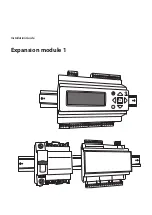
18
WHL-032 REV. 6.2.16
F. EXHAUST VENT AND INTAKE PIPE
Vents must be properly supported. The boiler exhaust and intake connections are not designed to carry heavy weight. Vent support
brackets must be
within 1’ of the boiler and the balance at 4’ intervals. Venting must be readily accessible for visual inspection for the
first 3’ from the boiler.
NOTE:
To prevent combustion air contamination, see Table 7 in this section when considering exhaust vent and intake pipe
termination.
Exhaust vent and intake pipe may be vented vertically through the roof or out a side wall. Venting methods are detailed in the Venting
Section. Do not attempt installation using any other means. Be sure to locate the boiler so exhaust vent and intake piping can be routed
through the building and properly terminated. Exhaust vent and intake piping lengths, routing, and termination method must comply with
methods and limits given in the venting section.
G. PREVENT COMBUSTION AIR CONTAMINATION
Install intake piping for the boiler as described in the Venting section. Do not terminate exhaust in locations that can allow
contamination of intake air.
Ensure that the intake air will not contain any of the contaminants below. For example, do not pipe intake near a swimming pool. Avoid
areas subject to exhaust fumes from laundry facilities. These areas always contain contaminants. Contaminated air will damage the
boiler, resulting in possible substantial property damage, severe personal injury, or death.
PRODUCTS TO AVOID
AREAS LIKELY TO HAVE CONTAMINANTS
Spray cans containing fluorocarbons
Dry cleaning/laundry areas and establishments
Permanent wave solutions
Swimming pools
Chlorinated waxes/cleaners
Metal fabrication plants
Chlorine-based swimming pool chemicals
Beauty shops
Calcium chloride used for thawing
Refrigeration repair shops
Sodium chloride used for water softening
Photo processing plants
Refrigerant leaks
Auto body shops
Paint or varnish removers
Plastic manufacturing plants
Hydrochloric or Muriatic acid
Furniture refinishing areas and establishments
Cements and glues
New building construction
Antistatic fabric softeners used in clothes dryers
Remodeling areas
Chlorine-type bleaches, laundry detergents, and cleaning solvents
Garages and workshops
Adhesives used to fasten building products
Table 7
NOTE: DAMAGE TO THE BOILER CAUSED BY EXPOSURE TO CORROSIVE VAPORS IS NOT COVERED BY WARRANTY.
(Refer to the limited warranty for complete terms and conditions).
H. REMOVING A BOILER FROM A COMMON VENT SYSTEM
Do not install the boiler into a common vent with any other boiler. This will cause flue gas spillage or boiler malfunction, resulting in
possible substantial property damage, severe personal injury, or death.
Failure to follow all instructions can result in flue gas spillage and carbon monoxide emissions, causing severe personal injury or death.
When removing an existing boiler, the following steps must be followed.
1. Seal any unused openings in the common venting system.
2. Visually inspect the venting system for proper size and horizontal pitch to determine if there is blockage, leakage, corrosion or other
deficiencies that could cause an unsafe condition.
















































